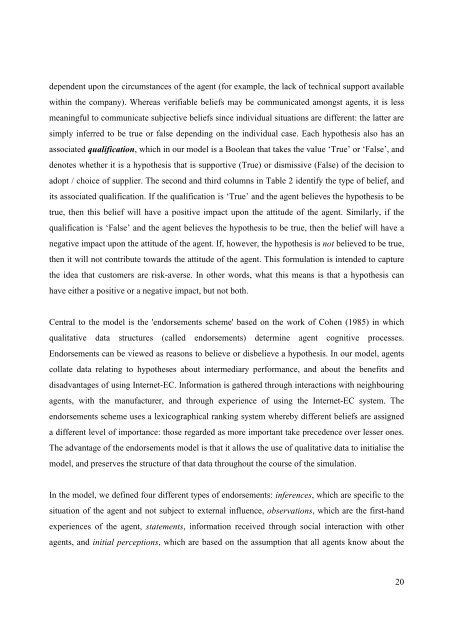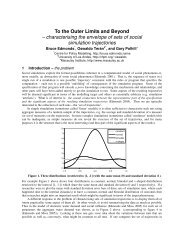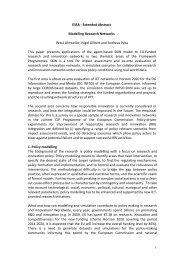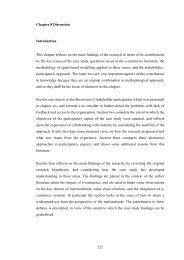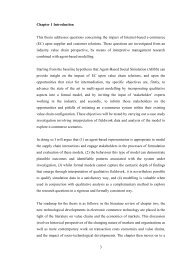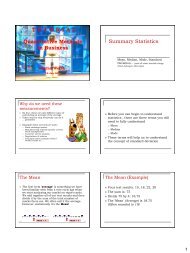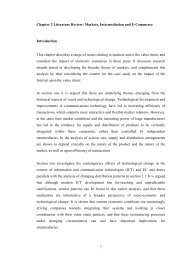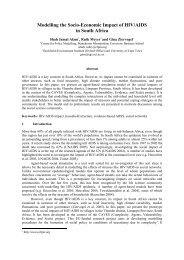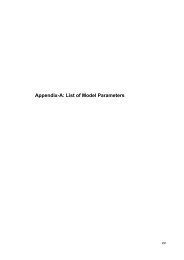1 Agent-Based Modelling Incorporating Qualitative and Quantitative ...
1 Agent-Based Modelling Incorporating Qualitative and Quantitative ...
1 Agent-Based Modelling Incorporating Qualitative and Quantitative ...
You also want an ePaper? Increase the reach of your titles
YUMPU automatically turns print PDFs into web optimized ePapers that Google loves.
dependent upon the circumstances of the agent (for example, the lack of technical support available<br />
within the company). Whereas verifiable beliefs may be communicated amongst agents, it is less<br />
meaningful to communicate subjective beliefs since individual situations are different: the latter are<br />
simply inferred to be true or false depending on the individual case. Each hypothesis also has an<br />
associated qualification, which in our model is a Boolean that takes the value ‘True’ or ‘False’, <strong>and</strong><br />
denotes whether it is a hypothesis that is supportive (True) or dismissive (False) of the decision to<br />
adopt / choice of supplier. The second <strong>and</strong> third columns in Table 2 identify the type of belief, <strong>and</strong><br />
its associated qualification. If the qualification is ‘True’ <strong>and</strong> the agent believes the hypothesis to be<br />
true, then this belief will have a positive impact upon the attitude of the agent. Similarly, if the<br />
qualification is ‘False’ <strong>and</strong> the agent believes the hypothesis to be true, then the belief will have a<br />
negative impact upon the attitude of the agent. If, however, the hypothesis is not believed to be true,<br />
then it will not contribute towards the attitude of the agent. This formulation is intended to capture<br />
the idea that customers are risk-averse. In other words, what this means is that a hypothesis can<br />
have either a positive or a negative impact, but not both.<br />
Central to the model is the 'endorsements scheme' based on the work of Cohen (1985) in which<br />
qualitative data structures (called endorsements) determine agent cognitive processes.<br />
Endorsements can be viewed as reasons to believe or disbelieve a hypothesis. In our model, agents<br />
collate data relating to hypotheses about intermediary performance, <strong>and</strong> about the benefits <strong>and</strong><br />
disadvantages of using Internet-EC. Information is gathered through interactions with neighbouring<br />
agents, with the manufacturer, <strong>and</strong> through experience of using the Internet-EC system. The<br />
endorsements scheme uses a lexicographical ranking system whereby different beliefs are assigned<br />
a different level of importance: those regarded as more important take precedence over lesser ones.<br />
The advantage of the endorsements model is that it allows the use of qualitative data to initialise the<br />
model, <strong>and</strong> preserves the structure of that data throughout the course of the simulation.<br />
In the model, we defined four different types of endorsements: inferences, which are specific to the<br />
situation of the agent <strong>and</strong> not subject to external influence, observations, which are the first-h<strong>and</strong><br />
experiences of the agent, statements, information received through social interaction with other<br />
agents, <strong>and</strong> initial perceptions, which are based on the assumption that all agents know about the<br />
20


